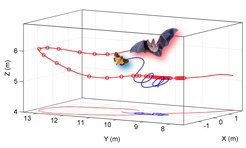Behavioural variability as anti-predator adaptation

Abstract Many prey animals show erratic and unpredictable movement, termed protean behaviour, as an anti-predator adaptation. Moths with ultrasound sensitive ears are a classic example for this behaviour, exhibiting both directional and erratic flight to escape from echolocating insectivorous bats. Moth families differ in the number of auditory receptor cells (1-4 cells) and their antipredator strategies, allowing for a comparative approach to study the function and adaptive value of evasive flight and protean escape mechanisms.
The well-studied neurobiology of the simple moth ear provides an ideal foundation for a systematic study of moth evasive flight, which is the phenotype selected by bat-predation. Using both tethered and free-flying moths in the lab, we will quantify the intra- and interspecific stereotypy and variability in evasive flight across moth species from different families. This data will be used to address biological hypotheses regarding the functional ecology of evasive flight in the face of predators, such as the risk-dependent evolution of erratic flight, sustained erratic flight without sensory input and phenotypic variability as adaptation to predation pressure.
We are looking for a dedicated candidate genuinely interested in bioacoustics, sensory ecology and animal behaviour, who is motivated to work both in the lab and field, potentially at night and at our field station in Bulgaria. Experience in these areas, as well as technical and programming skills and a driver’s licence can be advantageous. Please do not hesitate to contact Holger Goerlitz for further information.
Keywords predator-prey-interaction, protean behaviour, escape flight, moths, bats, bioacoustics
Main advisor Holger Goerlitz, MPIO Seewiesen
